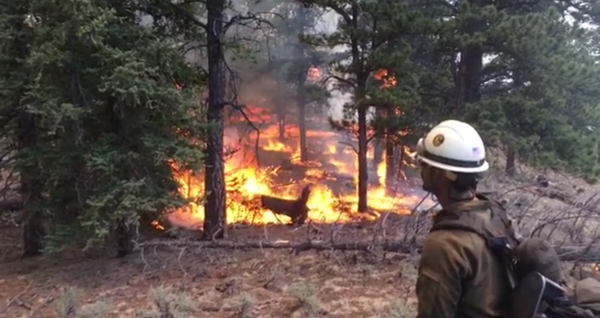
How a Wildland Firefighter Trains for Fire Season
5 March 2020
Wildland Firefighters work the frontlines to combat danger in extreme conditions. As such, they are held to rigorous fitness standards. Meet Bear Opitz, a Wildland Firefighter who puts his life at risk to protect our communities, forests, and grasslands. An excerpt below on how he trains for fire season.
By: Bear Opitz, Wildland Firefighter
Training for a Wildland Fire season is widely debated; everyone has a method to their madness. While every Wildland Firefighter should have their own system, below are a few training approaches during the off-season that have been successful for me when preparing for the upcoming fire season.
Running
Run everywhere— on trails, in the streets, up mountains. At the beginning of fire season, a lot of crews are tested at a mile and half distance, though it’s not necessary to run at a maximum speed every time (consider once a week or so). Run for time, rather than distance, as it tends to be a more accurate indicator of what workdays are like on the fire line. A goal to set might consist of running a minimum of 6 hours a week at various speeds and effort. Wildland firefighting is measured in a “two more chains” mindset, which usually means the end isn’t near; training should be geared towards endurance and durability. On a fourteen day fire assignment, day 11 often means physical and mental exhaustion, so proper training necessitates a personal engine that is good to go.
In such a dynamic work environment, understanding your body and how it feels is more important than the ability run a sub 3-hour marathon. As a competitive person by nature, running longer distances to build mental strength is important, but knowing how to scale it back when you are ‘redlining’ is equally as critical. At any moment during a fire, the wind could shift and the fire could quickly blast past the line the crew had prepped for the previous week. I have found that if you have mentally prepared because you challenged yourself physically in the off-season, it will be easier to adjust to that soul crushing shift.
Bear's favorite shoe is the All-Weather Gravity for winters in the Pacific Northwest.
Calisthenics and Core
Chest, shoulders, abs, and back muscles— what I refer to as “mountain core”— is a critical focus for building durability. Working on these areas entails push-ups, pull-ups, flutter-kicks, dips, and sit-ups—tens of thousands of them every off-season. Consider creating a calisthenics circuit so as to avoid burnout on one particular area. As a Wildland Firefighter it is necessary to be able to carry your own weight and gear, and unfortunately in an emergency, someone else’s weight. A good balance between both strength and endurance is imperative. What good would running a mile and a half in 7:30 do if you’re unable to raise a chainsaw to your shoulders while cutting the limbs off a tree? Building strength is necessary, and when supplemented with endurance-based workouts, can help you stay strong through 16-hour days.
Weighted Hikes
Day one of “critical 80,” or the first two weeks of training, is guaranteed to test hiking ability. Like running, you may never know how long a hike will last, which is why when training, shoot for time, not necessarily distance. During fire season, we are typically carrying a 40-pound pack in addition to a 28-pound chainsaw, often up a steep ridge. With off-season training, hiking with no more than 45 pounds for 2-4 hours is sufficient, as less weight helps to avoid injury. During the season, however, we aren’t left with much of a choice as far as time and weight; on a fire Durango, Colorado, I once hiked 17½ miles with pack and a chainsaw during our 16 hour shift. The next day, I woke up to another 15 miles. Unless you enjoy carrying a chainsaw and gear up a hill during off-season, weighted hikes are just about the closest thing you’ll get.
Generally, occupational fitness in wildland firefighting training is difficult to pinpoint, as some things you cannot physically replicate without actually doing the job itself. Cutting a thirty-foot prep through oak brush, picking up and throwing bucked logs, digging line for 5 straight hours before getting called to catch a spot fire are all circumstances that we regularly see in season. Endurance built through running, and strength built through weighted hikes and calisthenics help make the transition as seamless as possible. On the whole, I’ve given some insight into what I do for off-season training. I certainly have eased into it and have built my routine over several years while considering the things that get me both physically and mentally ready for another fire season. As with most training, small, consistent daily efforts over time, and recognizing when to push yourself and when to rest, allows you to stay healthy in this process. Ultimately, a proper training regimen is an individual endeavor that can be tailored for your personal fitness goals, and should be exercised with honesty and caution. Using these basic exercises has given me stability in a sometimes difficult off-season, as proper training can offer both a mental outlet and act as physical development tool.




